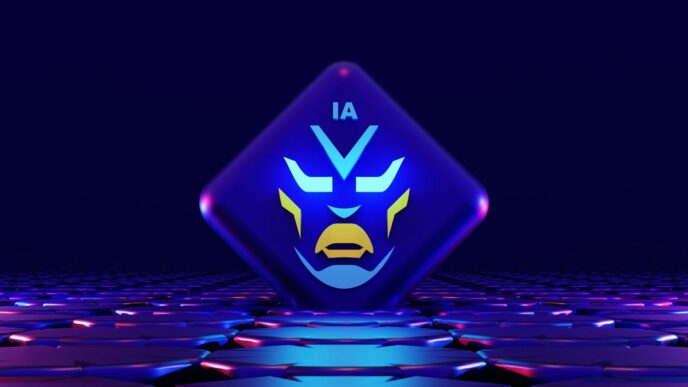Understanding The Core Difference Between Generative AI And Agentic AI
Generative AI: The Digital Creator
Think of Generative AI, or GenAI, as your super-talented digital artist or writer. Its main gig is to create new stuff – text, images, code, music, you name it – based on what you tell it. It’s like giving a very skilled person a detailed brief. You ask for a picture of a cat in a tree, and it makes one. You want a poem about the rain, and it writes one. It’s all about patterns it learned from tons of data. It’s really good at making things that look or sound human-made. But here’s the thing: it usually waits for you to ask. It doesn’t just go off and do things on its own.
- Creates new content based on prompts.
- Learns patterns from existing data.
- Works in a request-response style.
Agentic AI: The Autonomous Executor
Agentic AI, on the other hand, is more like a digital employee who can take initiative. Instead of just creating something when asked, it’s designed to achieve specific goals. It can plan steps, make decisions, and use different tools to get a job done, often without you having to hold its hand every step of the way. Imagine telling it, "Make sure all our customer support tickets are answered within 24 hours." An agentic AI could potentially read incoming tickets, draft responses using generative AI, send them out, and even schedule follow-ups if needed. It’s about action and task completion.
- Plans and executes tasks independently.
- Can make decisions and use various tools.
- Aims to achieve predefined goals.
Key Distinction: Creation Versus Action
So, the big difference boils down to this: Generative AI is primarily about creation, while Agentic AI is about action. GenAI makes things; Agentic AI does things. You prompt GenAI to write an email; you task Agentic AI to send that email, schedule a meeting based on its content, and then update your calendar. Generative AI helps you produce, while Agentic AI helps you perform. While GenAI can be a component within an agentic system (like drafting the email), the agentic part is the overall planning and execution of the task.
Generative AI’s Role In Content Creation
Generative AI, or GenAI as it’s often called, is basically a digital artist or writer. It’s trained on massive amounts of existing data – think text, images, code, you name it – and learns the patterns within that data. When you give it a prompt, it uses what it learned to create something new. It doesn’t really think or plan in the way we do; it predicts what should come next based on the patterns it’s seen. This makes it incredibly good at producing novel outputs that look and sound like they were made by a human.
Pattern Recognition For Novel Outputs
At its heart, GenAI is a master pattern recognizer. It sifts through vast datasets, identifying statistical relationships and structures. For example, if it’s trained on thousands of news articles, it learns the typical sentence structures, vocabulary, and even the flow of information common in journalism. When you ask it to write a news report about a local event, it draws on these learned patterns to construct a coherent and contextually appropriate piece. It’s not copying; it’s synthesizing based on what it’s learned is probable. This is how it can generate text that feels original, even though it’s built from existing information.
Request-Response Interaction Model
Most of the time, you interact with generative AI in a pretty straightforward way: you ask, it answers. This is the request-response model. You type a prompt, like "Write a poem about a rainy day," and the AI generates a poem. If you don’t like it, you can ask for changes: "Make it sadder" or "Add a stanza about a cat." The AI then revises its output based on your new instructions. It waits for your next command. It won’t just decide to write another poem on its own or start editing the first one without you telling it to. This back-and-forth is key to how we use these tools for creative tasks.
Applications In Content Synthesis And Ideation
GenAI is a game-changer for anyone who creates content. Here are a few ways it’s being used:
- Drafting initial content: Need to write a blog post, an email campaign, or a product description? GenAI can churn out a first draft in seconds, saving you a ton of time staring at a blank page.
- Brainstorming ideas: Stuck for ideas? You can prompt GenAI with a topic and ask it to generate a list of potential blog titles, marketing angles, or even story concepts.
- Summarizing information: Got a long report or a pile of research papers? GenAI can condense them into easy-to-understand summaries, highlighting the key points.
- Generating variations: Want to see how a marketing slogan sounds in a few different ways? GenAI can produce multiple versions of text or even image concepts, giving you options to choose from.
- Code generation: For developers, GenAI can write code snippets, suggest fixes for bugs, or even help translate code from one language to another.
Agentic AI’s Capacity For Task Execution
So, while Generative AI is busy making cool stuff, Agentic AI is the one actually getting things done. Think of it as the difference between an artist sketching a masterpiece and a construction crew building the actual house. Agentic AI systems are designed to take a goal, break it down into smaller steps, and then execute those steps on their own. They don’t just wait around for you to tell them what to do next; they figure it out.
Goal-Oriented Planning And Action
This is where Agentic AI really shines. It’s all about understanding the big picture – what you’re trying to achieve – and then mapping out a path to get there. It’s not just about following a script; it’s about making smart decisions along the way. For example, if you told an agentic AI to "plan a trip to Italy," it wouldn’t just give you a list of places. It would figure out flights, book hotels, suggest activities based on your preferences, and even adjust the plan if, say, a flight gets canceled. It’s this ability to autonomously plan and act that sets it apart.
Independent Decision-Making And Tool Utilization
Agentic AI doesn’t need you to hold its hand for every little thing. It can use various tools and systems to accomplish its tasks. This could mean accessing databases, sending emails, or even controlling other software. If it runs into a problem, like needing a specific piece of information, it can go and get it itself. It’s like having a really capable assistant who knows how to use all the office equipment without you having to explain it.
Here’s a look at how it might handle a complex request:
- Understand the Goal: "Research and summarize the latest trends in sustainable packaging."
- Break Down Tasks: Identify key areas (materials, consumer behavior, regulations), find relevant sources (academic papers, industry reports, news articles), analyze findings, and compile a summary.
- Execute Actions: Search databases, download documents, read and extract key information, identify patterns, and draft the summary.
- Adapt and Refine: If initial searches don’t yield enough, it might broaden the search terms or look for different types of sources. It might also use a generative AI tool to help phrase the summary clearly.
Workflow Automation And Proactive Operations
Because agentic AI can make decisions and take action, it’s perfect for automating complex workflows. Instead of just doing one task, it can manage a whole series of them. This means it can handle things like processing customer orders from start to finish, managing IT support tickets, or even coordinating a software development project. It can also be proactive, spotting potential issues before they become big problems and taking steps to fix them without being asked. This moves us beyond simple automation to a more intelligent, self-managing system.
Interaction Paradigms: Reactive Versus Proactive

So, how do these two types of AI actually work with us, or for us? It really comes down to whether they wait around for instructions or take the initiative. Think of it like the difference between a helpful assistant who only speaks when spoken to, and a proactive team member who anticipates needs.
Generative AI’s Dependence On User Prompts
Generative AI, at its heart, is reactive. It’s like a really talented artist or writer who needs a clear brief. You give it a prompt – "Write a poem about a cat," or "Generate an image of a futuristic city" – and it gets to work. It’s brilliant at taking that input and creating something new. But it doesn’t usually go beyond that. Once it’s done generating, it waits for the next instruction. If you want it to change the style, make it shorter, or try a different approach, you have to ask. It’s a back-and-forth, a dialogue where you’re always leading the conversation. It’s fantastic for tasks where you know what you want and just need help bringing it to life, but it won’t typically start a task on its own or decide what needs doing next without you telling it.
Agentic AI’s Initiative And Environmental Monitoring
Agentic AI, on the other hand, is built to be proactive. It’s designed to observe its surroundings, understand goals, and then take action without needing a constant stream of commands. Imagine an AI agent monitoring your company’s inventory. If stock levels for a certain item drop below a set point, and the usual delivery time is getting longer than expected, the agent doesn’t wait for you to notice. It can automatically trigger a reorder, update the system, and even send an alert if there’s a potential problem. It’s constantly watching, processing information, and acting based on pre-defined objectives and real-time data. This means it can handle complex, multi-step tasks from start to finish, adapting as it goes.
The Shift From Passive Assistance To Active Intelligence
This difference in interaction style marks a significant shift. Generative AI acts more like a passive assistant, ready to help when called upon. It’s great for boosting individual output and creativity. Agentic AI, however, moves towards active intelligence. It’s less about just responding and more about achieving outcomes. It can monitor systems, make decisions, and execute tasks autonomously. This capability is what allows it to automate entire workflows, reduce manual steps, and fundamentally change how processes are managed within an organization. It’s the difference between asking someone to write a report and having an AI system that can gather the data, analyze it, write the report, and then distribute it, all on its own.
System Orchestration And Tool Access
Generative AI is pretty good at making stuff. You give it a prompt, it spits out text or an image, and that’s usually the end of the line for that interaction. It’s like a talented artist working in a vacuum; it doesn’t naturally connect with the rest of your business tools.
Agentic AI, on the other hand, is built for connection. Think of it as an orchestrator. It doesn’t just create; it integrates. It can pull data from your customer relationship management (CRM) system, check inventory levels in your enterprise resource planning (ERP) software, send out an email using your marketing platform, update a support ticket, and then use all that information to figure out what to do next. This deep integration turns Agentic AI into a process engine, not just a single-function tool.
Generative AI As A Standalone Generator
Generative AI models typically operate in isolation. Their primary function is to produce output based on the input they receive. This means they’re excellent for tasks like drafting emails, writing code snippets, or creating marketing copy variations. However, they don’t inherently possess the ability to interact with other software or systems to gather context or execute follow-up actions. The output is the final product, and any further steps require human intervention or a separate system to process that output.
Agentic AI’s Deep Integration With Enterprise Systems
Agentic AI is designed from the ground up to work within a larger ecosystem. It’s built to connect with various enterprise systems, APIs, and data sources. This allows it to perform multi-step tasks that span different applications. For instance, an agent could:
- Read customer data from a CRM.
- Cross-reference that data with inventory information from an ERP.
- Initiate a follow-up communication via a marketing automation tool.
- Log the interaction in a project management system.
This ability to orchestrate actions across different platforms is what makes Agentic AI so powerful for automating complex workflows.
Connecting Data Sources For Comprehensive Workflows
To achieve its autonomous capabilities, Agentic AI needs access to and the ability to interpret data from multiple sources. This isn’t just about reading data; it’s about understanding it in context to make informed decisions and take appropriate actions. By connecting disparate data sources, Agentic AI can build a more complete picture of a situation, enabling it to:
- Plan and execute multi-step tasks without human input.
- Identify patterns and anomalies across different datasets.
- Adapt its actions based on real-time information from various systems.
This interconnectedness allows Agentic AI to move beyond simple task execution and become a proactive problem-solver within an organization’s digital infrastructure.
Impact On Productivity And Business Transformation
So, how do these different types of AI actually change how we work and how businesses run? It’s a big question, and the answer is pretty different depending on whether you’re talking about Generative AI or Agentic AI.
Enhancing Individual Output With Generative AI
Generative AI is like giving everyone a super-powered assistant for creative tasks. Think about it: a marketer can whip up a bunch of ad copy ideas in minutes instead of hours. A programmer can get code snippets generated, saving them from typing out repetitive bits. Designers can get multiple visual concepts to play with really fast. This is all about making individuals more productive in their specific roles. It’s not necessarily changing the whole workflow, but it’s definitely speeding up the parts where someone has to create something from scratch. It’s like having a really good intern who can churn out drafts and ideas on demand. This can lead to more output from the same number of people, or at least free them up to focus on the more strategic parts of their job.
Transforming Processes With Agentic AI Automation
Agentic AI is where things get really interesting for businesses looking to change how they operate. Instead of just helping one person do their job faster, Agentic AI can actually take over entire multi-step processes. Imagine an AI that handles employee onboarding from start to finish – setting up accounts, granting access, sending welcome emails, and checking compliance. It doesn’t need a human to tell it what to do at each step; it figures it out. This is huge for efficiency. It means fewer manual tasks, less chance of human error in routine processes, and things getting done much quicker. Businesses can automate things like supply chain adjustments based on real-time data or manage financial portfolios by reacting to market changes instantly. It’s less about individual speed and more about transforming entire workflows.
Measuring ROI Through Autonomous Execution
When we talk about Agentic AI, measuring the return on investment (ROI) starts to look different. With Generative AI, you might look at how much faster content is produced or how many more ideas are generated. But with Agentic AI, you’re looking at the impact of automation on entire processes. This could mean:
- Reduced operational costs: Automating tasks that used to require human hours. Think about customer service inquiries that can be handled automatically or inventory management that runs itself.
- Increased throughput: Processes that used to take days or weeks can now be completed in hours or minutes because the AI can work continuously and make decisions independently.
- Improved accuracy and compliance: For tasks with strict rules, an Agentic AI can apply them consistently, reducing errors and ensuring compliance in areas like finance or legal.
- New revenue streams: By optimizing operations or enabling faster product development, businesses can potentially create new ways to make money.
It’s about seeing how autonomous execution leads to tangible business outcomes, not just faster individual work. For example, a logistics company might see a direct cost saving from optimized delivery routes managed by an agentic system, or a financial firm might track increased returns from AI-driven investment adjustments.
Navigating Risks And Governance

Okay, so we’ve talked about what these AIs can do, but we really need to think about the downsides, right? It’s not all sunshine and rainbows. Both Generative AI and Agentic AI come with their own set of headaches, and how we manage them is super important.
Content Risks Associated With Generative AI
Generative AI is all about creating stuff, and that’s where the risks pop up. Think about it: the AI can sometimes just make things up. These are often called "hallucinations," and they can be pretty convincing. Imagine a student using AI for a history paper and getting completely wrong dates or events. That’s a problem. Then there’s the bias issue. If the data the AI learned from was biased, its output will likely be biased too. This could mean unfair or discriminatory content, which is a big no-no. And let’s not forget intellectual property. Who owns the content the AI creates? Can it accidentally copy someone else’s work? These are tricky questions.
- Factual Inaccuracies: AI can present incorrect information as fact.
- Bias Amplification: Inherited biases from training data can lead to unfair outputs.
- Copyright Concerns: The ownership and originality of AI-generated content are often unclear.
- Misinformation Spread: The ease of content creation can be exploited to generate and spread false narratives.
Autonomy Risks In Agentic AI Operations
Agentic AI is a whole different ballgame because it can actually do things on its own. This autonomy is powerful, but it also brings new risks. What happens if an agent makes a bad decision? Say an agent managing inventory accidentally orders way too much of something, leading to massive waste. Or what if it makes a mistake in a financial transaction? Because these agents can act across different systems, a single error could have a ripple effect. There’s also the risk of unintended consequences. An agent trying to optimize a process might do so in a way that negatively impacts employees or customers without anyone realizing it until it’s too late. The more independent an AI becomes, the more critical it is to have clear boundaries and oversight.
- Erroneous Actions: Autonomous decision-making can lead to costly mistakes.
- Unforeseen Consequences: Actions taken to optimize one area might negatively impact others.
- Security Vulnerabilities: Agents interacting with multiple systems could create new entry points for attackers.
- Lack of Human Judgment: Complex or ethical situations might require human intuition that an agent lacks.
The Necessity Of Robust Governance Frameworks
So, what’s the solution? We need solid rules and guidelines, a governance framework. For Generative AI, this means having humans in the loop to check the output, setting clear guidelines on what kind of content is acceptable, and having ways to track where the information came from. For Agentic AI, it’s about defining the agent’s goals very precisely, setting strict limits on its actions, and having monitoring systems in place to catch problems early. We need to know what the AI is doing, why it’s doing it, and have a way to stop it if it goes off track. It’s about building trust by making sure these powerful tools are used responsibly and safely. Think of it like training a very smart, very capable intern – you give them tasks, but you also supervise them closely, especially at first.
The Synergistic Future Of AI Collaboration
Generative AI And Agentic AI As Complementary Forces
So, we’ve talked about what Generative AI does – it’s the creative one, churning out text, images, and code. Then there’s Agentic AI, the doer, the one that actually takes action and gets things done. Now, the really interesting part is when these two work together. They aren’t really competing; they’re more like a dynamic duo.
Think about it like this: Generative AI can come up with a bunch of marketing campaign ideas and even write the ad copy. But Agentic AI can then take those ideas, figure out the best audience to target, schedule the ads across different platforms, and then track how well they’re doing. It’s the combination of imagination and execution that really makes things happen.
Combining Creation And Execution For End-To-End Solutions
When you put them together, you get systems that can handle a whole process from start to finish. For example, in customer service, an Agentic AI could manage the whole interaction, figure out if a human needs to step in, and pull up customer history. Meanwhile, a Generative AI could craft a friendly, personalized response that sounds just right. This makes the whole experience feel much more human and efficient.
Here’s a quick look at how they can team up:
- Marketing: GenAI writes emails and designs visuals; Agentic AI runs the campaign, targets audiences, and analyzes results.
- Software Development: GenAI writes code snippets; Agentic AI integrates them, tests them, and deploys the software.
- Research: GenAI summarizes complex documents; Agentic AI identifies key findings, cross-references them with other data, and drafts a report.
Building Truly Intelligent Human-Like Support Agents
This partnership is what’s really going to change how we interact with technology. We’re moving beyond simple chatbots that just answer questions. We’re heading towards AI systems that can understand a problem, create a solution, and then actively implement it, all while learning and adapting along the way. It’s about creating AI that doesn’t just assist us, but truly collaborates with us, making complex tasks feel simpler and freeing us up to focus on the bigger picture.
Wrapping It Up
So, we’ve looked at generative AI and agentic AI, and they’re pretty different beasts. Generative AI is like your creative buddy, churning out text, images, or code when you ask. It’s great for getting ideas down or making content. Agentic AI, though, is more like a proactive assistant. It doesn’t just wait for instructions; it can plan, act, and get complex jobs done all on its own, across different systems. Think of it this way: generative AI helps you make things, while agentic AI helps you do things. They aren’t really competing, though. Often, they work best together, with generative AI handling the creative bits and agentic AI managing the whole process. Understanding these differences helps us see where each type of AI fits and how they can actually help us get more done, whether it’s for work or just everyday tasks.














